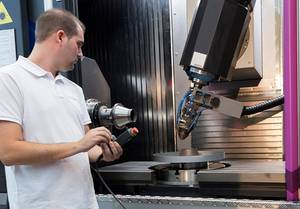Metal Printing Status
2020/05/21 Roa Zubia, Guillermo - Elhuyar Zientzia
The 3D printer is in a funny sense. Get a strange effect: Invented in the 1980s, we continue to talk about it as the latest technology. The truth is that the same has happened with drones, with various electronic devices, etc. The key is perception. The 3D printer looks modern and modern, but it is not the latest technology.

It is not the latest technology, but in part yes. 3D printing is in continuous progress. We invented new applications. And above all, we are increasingly using more 3D printing materials. Maybe that's a reason to think it's new.
Conventional 3D printers print polymer instead of printing ink. They are often typical polymers, common plastics: ABS, or polylactic acid, or PET (polyethylene terephthalate), etc. ABS is a copolymer: A-B-S Acrylonitrile Butadiene and Styrene (ABS). That said looks like a very sophisticated (and chemically sophisticated) material, but if I tell you that LEGO parts make them with ABS, you will understand that it is a conventional plastic. And PET, polyethylene terphthalate, is the material of water bottles.
But my intention was not to talk about polymers, but about metals because we are increasingly using more metals in 3D printers. Not in domestic 3D printers, but in the industry: for the manufacture of aeronautical parts or for medicine, for example. Companies that manufacture complex aircraft parts are printing aluminum in aeronautics. It is not usually pure aluminum, but aluminum alloys containing another metal. And parts printed in medicine with titanium. Titanium and medicine. This couple does not need much presentation.
But there are more examples: there are many industries that use steel, and alloys between gallium and Indian, chromium and cobalt are also used, etc.
The problem is that most 3D printers have to heat the material. Usually the metal is found in the form of powder, melts with heat and merge into the desired shape. Imagine the temperature to be reached in the case of steel, for example.
Why am I counting all this. The idea was that I wanted to justify that some 3D printers are the latest technology. I say yes. This technology remains, in some cases, at the laboratory level, at the research level. The example published in the journal Science in one of the May 2020 numbers may serve: a study on how metal particles absorb energy when metal dust is heated. And it is not yet clear how it occurs at the atomic level. And if the product is a piece we are using during a flight, for example, it is clear that we need to know exactly what happened at the time of the manufacture of that part, right?

Gai honi buruzko eduki gehiago
Elhuyarrek garatutako teknologia






